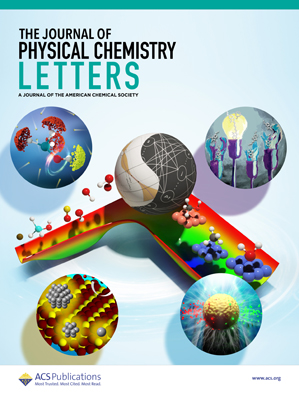等离子体纳米粒子干涉散射光谱中的散射与干涉
IF 4.6
2区 化学
Q2 CHEMISTRY, PHYSICAL
引用次数: 0
摘要
干涉散射(iSCAT)是研究单个等离子纳米粒子(NPs)的有力工具,尤其是当粒子变得太小而无法仅通过其散射信号进行观测时。这种对 NP 大小的敏感性使该技术成为监测 NP 在电化学或其他反应环境中动态形态变化的有效工具。然而,由于 iSCAT 测量的信号包括 NP 的散射及其与反射参考场的干扰,基底和局部环境的作用可能会产生巨大影响,导致 iSCAT 和暗场散射光谱之间存在显著差异,即使对于散射预期占主导地位的大颗粒也是如此。在这项研究中,我们展示了通过改变嵌入介质的折射率、基底-介质界面的反射率以及 NP 的大小,可以在散射或干涉主导的体系之间调整金 NP 的 iSCAT 对比光谱。我们将 iSCAT 光谱与暗场散射光谱进行比较,以说明干涉贡献如何使光谱特征偏离质子共振,并使用偶极子振荡器模型来解释观察到的光谱线形。最后,我们展示了在电解实验过程中测量多个照明波长的 iSCAT 信号的必要性,以提取代表 NP 形态变化的动力学参数。本文章由计算机程序翻译,如有差异,请以英文原文为准。

Scattering vs Interference in Interferometric Scattering Spectroscopy of Plasmonic Nanoparticles
Interferometric scattering (iSCAT) is a powerful tool to study single plasmonic nanoparticles (NPs), particularly when the particles become too small to be observed by their scattering signal alone. This sensitivity to NP size makes the technique a promising tool to monitor dynamic morphological changes in NPs in electrochemical or other reactive environments. However, because the signal measured in iSCAT consists of both the NP scattering and its interference with a reflected reference field, the role of the substrate and local environment can have an outsize influence, leading to significant differences between iSCAT and dark-field scattering spectra, even for large particles where scattering is expected to dominate. In this work, we show that the iSCAT contrast spectra of gold NPs can be tuned between scattering- or interference-dominated regimes by changing the refractive index of the embedding medium, the reflectivity of the substrate–medium interface, and the size of the NP. We compare the iSCAT spectra to dark-field scattering spectra to show how the interference contribution can shift spectral features away from the plasmon resonance and use a dipole oscillator model to explain the observed spectral lineshapes. Lastly, we demonstrate the need to measure the iSCAT signal at multiple illumination wavelengths during electrodissolution experiments to extract kinetic parameters that are representative of the NP’s morphological changes.
求助全文
通过发布文献求助,成功后即可免费获取论文全文。
去求助
来源期刊

The Journal of Physical Chemistry Letters
CHEMISTRY, PHYSICAL-NANOSCIENCE & NANOTECHNOLOGY
CiteScore
9.60
自引率
7.00%
发文量
1519
审稿时长
1.6 months
期刊介绍:
The Journal of Physical Chemistry (JPC) Letters is devoted to reporting new and original experimental and theoretical basic research of interest to physical chemists, biophysical chemists, chemical physicists, physicists, material scientists, and engineers. An important criterion for acceptance is that the paper reports a significant scientific advance and/or physical insight such that rapid publication is essential. Two issues of JPC Letters are published each month.
 求助内容:
求助内容: 应助结果提醒方式:
应助结果提醒方式:


